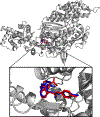Strategies for targeting the cardiac sarcomere: avenues for novel drug discovery
- PMID: 32067508
- PMCID: PMC7065952
- DOI: 10.1080/17460441.2020.1722637
Strategies for targeting the cardiac sarcomere: avenues for novel drug discovery
Abstract
Introduction: Heart failure remains one of the largest clinical challenges in the United States. Researchers have continually searched for more effective heart failure treatments that target the cardiac sarcomere but have found few successes despite numerous expensive cardiovascular clinical trials. Among many reasons, the high failure rate of cardiovascular clinical trials may be partly due to incomplete characterization of a drug candidate's complex interaction with cardiac physiology.Areas covered: In this review, the authors address the issue of preclinical cardiovascular studies of sarcomere-targeting heart failure therapies. The authors consider inherent tradeoffs made between mechanistic transparency and physiological fidelity for several relevant preclinical techniques at the atomic, molecular, heart muscle fiber, whole heart, and whole-organism levels. Thus, the authors suggest a comprehensive, bottom-up approach to preclinical cardiovascular studies that fosters scientific rigor and hypothesis-driven drug discovery.Expert opinion: In the authors' opinion, the implementation of hypothesis-driven drug discovery practices, such as the bottom-up approach to preclinical cardiovascular studies, will be imperative for the successful development of novel heart failure treatments. However, additional changes to clinical definitions of heart failure and current drug discovery culture must accompany the bottom-up approach to maximize the effectiveness of hypothesis-driven drug discovery.
Keywords: Drug discovery; biophysical measurements; cross-bridge kinetics; heart failure; in vivo function; sarcomere-based therapy; solution-based chemistry.
Conflict of interest statement
Declaration of Interest:
The authors have no other relevant affiliations or financial involvement with any organization or entity with a financial interest in or financial conflict with the subject matter or materials discussed in the manuscript apart from those disclosed.
Figures


References
-
- Desai AS, Stevenson LW. Rehospitalization for Heart Failure. Circulation. 2012;126:501–506. - PubMed
-
- Cook C, Cole G, Asaria P, et al. The annual global economic burden of heart failure. Int. J. Cardiol 2014;171:368–376. - PubMed
-
-
Ahmad T, Miller PE, McCullough M, et al. Why has positive inotropy failed in chronic heart failure? Lessons from prior inotrope trials. Eur. J. Heart Fail 2019;21:1064–1078.
** Discusses the challenges faced by clinical trials of inotropic cardiac drugs and serves as the main motivation for this review.
-
-
- Hay M, Thomas DW, Craighead JL, et al. Clinical development success rates for investigational drugs. Nat. Biotechnol 2014;32:40–51. - PubMed
-
- Harrer S, Shah P, Antony B, et al. Artificial Intelligence for Clinical Trial Design. Trends Pharmacol. Sci 2019;40:577–591. - PubMed
Publication types
MeSH terms
Substances
Grants and funding
LinkOut - more resources
Full Text Sources
Medical
